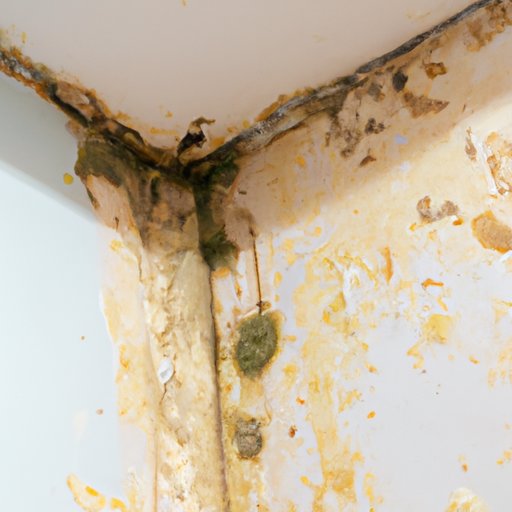Introduction
Mold in the bathroom is an all-too-common problem, but is it dangerous? Fortunately, the answer is no — provided that you take steps to address the problem quickly and correctly. In this article, we’ll explore the dangers of bathroom mold and provide you with the information you need to make sure your bathroom is safe from mold-related health risks.

What You Need to Know About Bathroom Mold
The first step to preventing and treating bathroom mold is knowing its causes, types, and signs. Here’s what you should look out for:
Causes of Bathroom Mold
Bathroom mold is usually caused by excessive moisture. This could be due to condensation on walls, pipes, or fixtures, leaking plumbing, or poor ventilation. If your bathroom isn’t properly ventilated, the warm air that accumulates during showers and baths will form droplets on cold surfaces like tile and mirrors, eventually leading to mold growth.
Types of Bathroom Mold
The most common type of mold found in bathrooms is Cladosporium. This type of mold is dark green or black in color and often appears in damp areas like shower stalls and bath tubs. Other types of mold, such as Aspergillus, Penicillium, and Alternaria, can also be found in bathrooms. These molds are typically white or gray in color and tend to grow on walls and ceilings.
Signs of Bathroom Mold
The telltale signs of bathroom mold are visible patches of discoloration on walls, ceilings, and other surfaces. The patches may be black, green, white, or gray in color. You may also notice a musty smell in the room, which is caused by airborne mold spores.
Is Mold in Your Bathroom Putting You at Risk?
Now that you know what to look for, it’s time to consider the potential health risks associated with bathroom mold. While not all types of mold are dangerous, some can cause serious health problems.
Health Risks Associated with Bathroom Mold
Exposure to mold can cause respiratory issues, allergies, and skin irritation. People with weakened immune systems or existing respiratory conditions such as asthma are particularly vulnerable to the effects of mold. In extreme cases, long-term exposure to certain types of mold can lead to serious illnesses such as lung infections.
Who is Most Vulnerable to Health Risks from Bathroom Mold?
Infants, children, and elderly people are more likely to experience negative health effects from mold exposure. People who have compromised immune systems, such as those undergoing chemotherapy, are also at greater risk. Additionally, individuals with pre-existing respiratory conditions, like asthma, may be more susceptible to the effects of mold.
How to Prevent and Treat Bathroom Mold
Now that you know the risks associated with bathroom mold, it’s time to discuss how to prevent and treat it. Here are some tips to help keep your bathroom mold-free:
Ways to Prevent Bathroom Mold
The best way to prevent bathroom mold is to reduce moisture levels in the room. This can be accomplished by installing an exhaust fan or dehumidifier, using a squeegee after showers and baths, and ensuring that windows are open when possible. It’s also important to regularly check for any leaks or water damage, as these can lead to mold growth.
Cleaning Up Existing Bathroom Mold
If you already have bathroom mold, it’s important to take steps to clean it up as soon as possible. Start by scrubbing the affected area with a mixture of bleach and water. Once the mold has been removed, use an anti-fungal cleaner to ensure that all spores have been destroyed. Finally, apply a mold-resistant sealant to the area to prevent future growth.

Tips for Dealing with Dangerous Bathroom Mold
In addition to the above steps, there are several other measures you can take to minimize the risk of bathroom mold. Here are some tips:
Proper Ventilation
Ensure that your bathroom has adequate ventilation. Install an exhaust fan or dehumidifier, and open windows whenever possible. This will help to reduce moisture levels in the room and reduce the likelihood of mold growth.
Regular Maintenance
Perform regular maintenance on your bathroom to identify any potential sources of moisture. Check for leaking pipes, broken seals, and other areas where moisture may be accumulating. Taking preventive steps now can help you avoid major problems down the road.
Professional Help
If you suspect that your bathroom has a mold problem, it’s best to seek professional help. A qualified mold remediation specialist can assess the situation and recommend the best course of action.
Conclusion
Bathroom mold can be a serious problem, but it doesn’t have to be. By understanding the causes, types, and signs of bathroom mold, as well as the associated health risks, you can take the necessary steps to prevent and treat the issue. Proper ventilation, regular maintenance, and professional help can all help to keep your bathroom mold-free and safe.
Remember, bathroom mold can have serious consequences, so it’s important to take action as soon as possible. With the right knowledge and precautions, you can keep your family safe from the dangers of bathroom mold.


